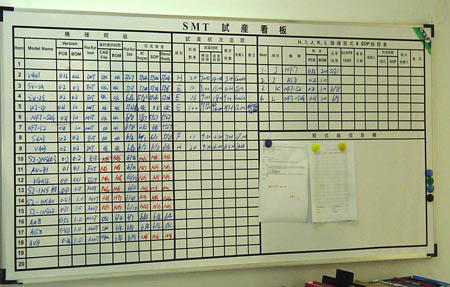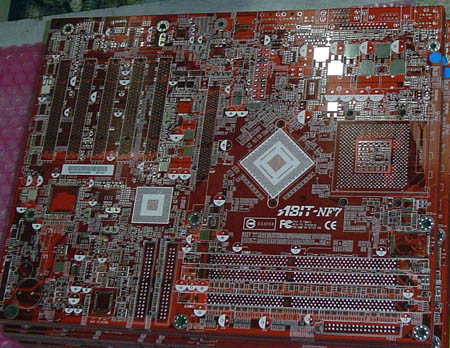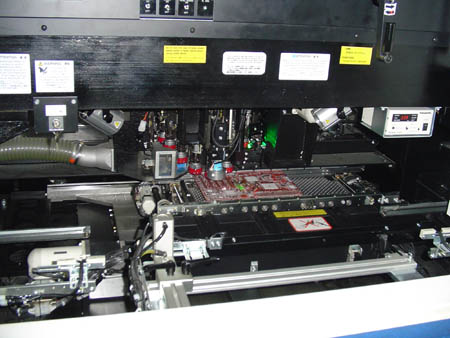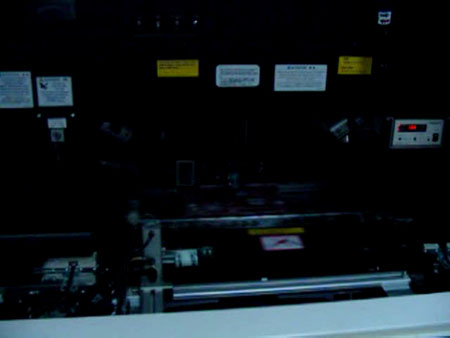The Birth of an Abit NF7 - A Factory Tour
by Kristopher Kubicki on June 11, 2004 10:12 PM EST- Posted in
- Motherboards
SMT
And now, the part that we have all been waiting for - the birth of an NF7. Unfortunately, the unison of science and art comes particularly unceremoniously in crates of 1000. Since Abit has no PCB production facilities, four- and six-layer motherboards are shipped from out-sourced facilities, pre-traced and pre-painted. Abit Taiwan designs the PCB and sends the schematics to an OEM factory. The factory manufactures and delivers the PCB to Rolly. For a quick primer on how the PCB is constructed, check out the primer that we gave in our ECS factory tour last year.Before walking onto the SMT lines, we are presented with a small office that controls the CAD/CAM devices on the floor. This mission control board shows when each machine was last tested, from where and when the PCB for that production came, and other process vitals.
Above is an Abit NF7 PCB as Rolly receives it. These boards have already been drilled and have passed electrical quality assurance tests at the OEM. The Rolly facility will mount components via SMT, manual labor and then package the board at this facility.
SMT is a term used frequently in any sort of electrical assembly. It stands for "surface-mount technology". As motherboard speed increases, their feature set and complexity increases even faster, although disproportionately . Motherboards like the NF7 have upwards of several thousand integrated circuits (ICs) under a millimeter in length, soldered onto the traces of the motherboard. Although labor is cheap in China, such precision and finesse are required to place delicately the thousands of resistors, ceramic capacitors and other integrated circuits (SMDs) that only a preprogrammed machine can accomplish. Below, you can see one of Abit's two-years-old SMT machines placing components on the NF7 PCB.
A colleague of mine recently described SMT as "a high-powered machine gun spitting ICs onto a board with insane precision." There really is not a more accurate description. Since SMDs are stamped onto the board at such high speeds, they are loaded into the SMT machine using a special tape feeder. This is very similar to the manner in which ammunition is fed into a machine gun. Below is a quick video sample of how the entire process looks in real time.














19 Comments
View All Comments
KristopherKubicki - Sunday, June 13, 2004 - link
Got it, thanks.Kristopher
kalaap - Sunday, June 13, 2004 - link
"This is actually the second over on the production line; the first is used right after SMT."I think you meant second OVEN.
AtaStrumf - Sunday, June 13, 2004 - link
Right Click --> Save Target As... ---> save to disk and play from there. If its still not working you need a new player. Real One Player is preety good.roostercrows - Sunday, June 13, 2004 - link
can someone tell me which video players you guys use? i couldn't get my realplayer to download the videos. thanksDonB - Sunday, June 13, 2004 - link
"...why there are more women than men". Women have much better manual dexterity than men. Remember typing classes in high school? I remember in my class, after the first semester, the females were typing around 40-50 wpm while the males were typing around 25-35 wpm, almost without exception.CurtOien - Sunday, June 13, 2004 - link
"The machine technician and the traditional visual inspectors are paid about the same; usually around $100 per month with lodging."I wonder how much the executives make?
AtaStrumf - Sunday, June 13, 2004 - link
The problem that I see with their testing procedure is that they probably only test at default settings, which is just not good enough for an enthusiast targeted motherboard. Sure my KT7 A worked fine at 100 MHz FSB, but it didn't at 133 MHz FSB, and my latest AN7 works fine at default BIOS setting, but when you change something strange things start to happen.I understand that they're in a hurry, but they should at least test at the most stressful settings that the mobo is supposed to function properly i.e. 200 MHz FSB and not 133 or. 166 MHz. What good is a 24 h burn-in test if it's done at 133 MHz FSB, and I'm gonna be using a 200 MHz FSB.
For instance this AN7 that I have now, works perfectly if I OC my 2500+ with the default offered 3200+, but if I change the FSB manualy to 200 its totaly unstable. How strange is that?
KristopherKubicki - Sunday, June 13, 2004 - link
artifex: I have not heard that reason for using women over men in facilities.What other economic information were you interested in? I can add it to the article.
Kristopher
artifex - Sunday, June 13, 2004 - link
I couldn't get the n7_fail image to load (ironic), but other than that, everything was good.Is it still true that another reason why there are more women than men on the assembly line is because womens' hands are generally thought to be smaller, and more adept?
I'd like to see more of the background economic information like what you provided for this story, next time you do a plant tour, too.